Translate this page into:
The Status of Liver Transplantation in India
Correspondence to SAMIRAN NUNDY; snundy@hotmail.com
[To cite: Tiwari P, Nundy S. The status of liver transplantation in India. Natl Med J India 2025;38:30–4. DOI: 10.25259/NMJI_528_2024]
Abstract
Background
The passage of the Transplantation of Human Organs Act in 1994 banned the unethical trade in human kidneys and recognized heart beating brain death as a form of death. This enabled liver transplantation to be performed in India. We briefly recount the history of the Act’s passage and describe, in some detail, the present status of the procedure.
Methods
We sent a questionnaire regarding liver transplant services via email to 400 members of the Liver Transplant Society of India requesting them to provide details on liver transplantation at their centres up to 2022. We received information on 3069 of 3920 transplants that had been performed in 2022.
Results
There were 183 registered centres who had performed a total of 3920 liver transplants, placing India in third position behind the USA (n=9528) and China (n=6053) while it performed the largest number of living donor liver transplants (n=3183) in the world. The most common indication for liver transplantation was non-alcoholic steatohepatitis (NASH)-related cirrhosis (20%). Our teams published 2449 PubMed indexed research papers and 384 foreign trainees came from 52 countries for training in liver transplantation. The concerns were the small numbers of deceased organ donation, the dominance of the private sector (96.7%), corruption in the form of kickbacks and false declarations of relationship and gender imbalance with only 22% women recipients receiving organs from men while 68% women donated their livers to men.
Conclusion
Liver transplantation has saved the lives of many Indians, made a major impact on Indian healthcare overall, and increased its reputation worldwide. There are problems which we hope will be tackled by increasing societal awareness.
INTRODUCTION
In 1988, it was estimated that about 200 000 people were dying from liver failure every year in India with no hope of survival. At the same time there were 60 000 liver transplants being done every year in the USA and Europe, with an 80% success rate and 70% 5-year survival.1 Moreover the trade in human organs in India was widespread and legal consisting mainly of kidney ‘donation’ from the poor to the rich via exploitative middlemen. The very rich Indians went abroad for liver transplants where they often had to wait 6 months for a deceased donor organ when there was no local recipient and the liver they received was often of a ‘marginal’ quality. The middle class and poor were left to die because, unlike in kidney failure where dialysis prolonged lives, there was no ‘replacement therapy’ for the liver.
It was only in 1989, that Shri Rajiv Gandhi, the then Prime Minister after a trip abroad wondered why we did not have liver and heart transplants done in India and asked the Health Minister to investigate the problem. He in turn then formed a Committee to examine the situation and propose some solutions. The problems identified by the group were:
That whereas heart beating brain death after which liver and heart transplants (which needed continuing blood flow), could be performed was recognized in western countries the Indian law only recognized cardiac death after the heart had stopped.
There was also, at that time, a lack of local surgical and medical expertise.
The kidney trade was widespread and had sullied the country’s reputation.
There were the enormous costs involved.
However, some people decided to tackle these problems and help introduce liver transplantation into India. This would save many young productive lives, become accessible and affordable to our countrymen and boost the nation’s all-round health prowess.
They embarked on a public education and awareness campaign by organizing conferences and lecturing widely, speaking with politicians and explaining the problems in the media––newspapers and television. Eventually after 4 years of sustained efforts ‘The Transplantation of Human Organs Act’ was passed by Parliament in 1994 and soon afterwards a successful heart transplant was performed by Late Dr P. Venugopal at the All India Institute of Medical Sciences, New Delhi.2
The first successful liver transplant from a deceased donor was performed by Drs A.S. Soin and M. Rajasekhar at the Apollo Hospital, New Delhi in 1998.3 Since then the number of liver transplants performed annually in India has reached 3920 in 2022 and the results of the best centres compare well with those done worldwide.4 Not only does liver transplantation in India attract patients from all over the world but many surgeons from both the developing and developed nations are coming here to learn how to do the procedure especially the partial living donor operation in which Indian surgeons now perform the largest numbers in the world. We recount how all this happened and survey the status of liver transplantation in India.
METHODS
To collect the desired information, we sent emails to all 400 members of the Liver Transplant Society of India with reminders asking them to provide us with the following information regarding their experience, i.e.
Centre’s name and location
Total number of liver transplants performed until December 2022 and in the year 2022 (with division into deceased and living donors)
Indications for liver transplantation
Leading liver transplant surgeons
Comparison with the world
The dominance of the private sector and gender imbalance
Academic output
Honours and awards received from national and international bodies
Countries of origin of visitors and trainees
Of the total 3920 liver transplants performed in 2022, we received responses from those who performed 3069 (78.3%).4
THE PAST AND THE PRESENT
Number of transplants performed and distribution of centres
Until May 2007, 22 centres in India were registered for liver transplants, and at least 14 of them had done at least one. During this time, 346 liver transplants took place in India, with 250 from live donors and 96 from deceased donors. There were only 4 centres who performed transplants in double digits, i.e. Sir Ganga Ram Hospital, New Delhi (140) followed by Indraprastha Apollo, New Delhi (102), Global Hospital, Hyderabad (28) and Sanjay Gandhi Postgraduate Institute of Medical Sciences, (SGPGIMS), Lucknow (14).5 The year-wise number of liver transplants done from 2009 to 2022 are shown in Fig. 1. These have almost doubled every 4 years.6
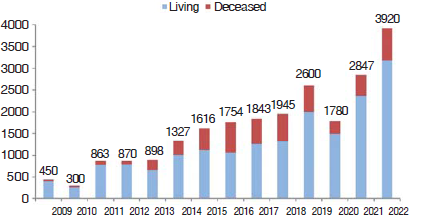
- Total number of transplants performed year-wise (living and deceased donations)
Presently 183 centres are registered for liver transplants excluding those registered only for retrieval. Tamil Nadu has the largest number (42), followed by Maharashtra (36), Karnataka (25), Kerala and Delhi (11 each). Eleven states do not have any liver transplant centres most of which are in the northeast region and 15 states have less than 10 centres.7 The largest number of liver transplants are being done in the Delhi National Capital Region (NCR) region (1548; 39.5%) and in southern India (Tamil Nadu, Telangana, Kerala, Karnataka (1626; 41.5%) while in the West, Maharashtra and Gujarat did 606 (15.5%; Table I).
| State | Number of centres | Number of liver transplants in 2022 | ||
|---|---|---|---|---|
| Live | Deceased | Total | ||
| Delhi NCR | 11 | 1514 | 34 | 1548 |
| Tamil Nadu | 42 | 490 | 142 | 632 |
| Maharashtra | 36 | 328 | 92 | 420 |
| Telangana | 9 | 228 | 171 | 399 |
| Kerala | 11 | 331 | 13 | 344 |
| Karnataka | 25 | 127 | 124 | 251 |
| Gujarat | 5 | 62 | 124 | 186 |
| Rajasthan | 5 | 28 | 5 | 33 |
| Andhra Pradesh | 4 | 8 | 15 | 23 |
| West Bengal | 3 | 11 | 12 | 23 |
| Madhya Pradesh | 9 | 13 | 4 | 17 |
| Chandigarh | 1 | 16 | 0 | 16 |
| Chhattisgarh | 2 | 12 | 2 | 14 |
| Uttar Pradesh | 5 | 4 | 4 | 8 |
| Puducherry | 2 | 1 | 4 | 5 |
| Odisha | 1 | 1 | 0 | 1 |
| Haryana | 7 | 0 | 0 | 0 |
| Assam | 2 | 0 | 0 | 0 |
| Bihar | 1 | 0 | 0 | 0 |
| Punjab | 3 | 0 | 0 | 0 |
NCR National Capiral Region
Indications for liver transplantation
The most common indications were alcoholic and non-alcoholic steatohepatitis (NASH)-related cirrhosis (20%) followed by hepatitis B virus cirrhosis (11%; Fig. 2).
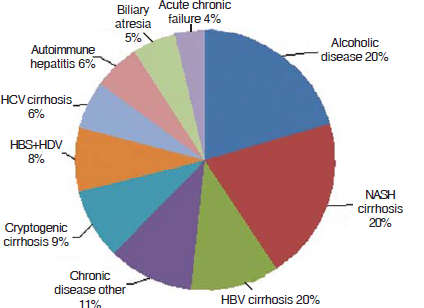
- Indications for liver transplantation in India
Leading liver transplant surgeons
Presently we have about 500 liver transplant surgeons in India with the top 10 having performed more than 1000 liver transplants (Fig. 3) and have established a reputation not only in India but in the world.
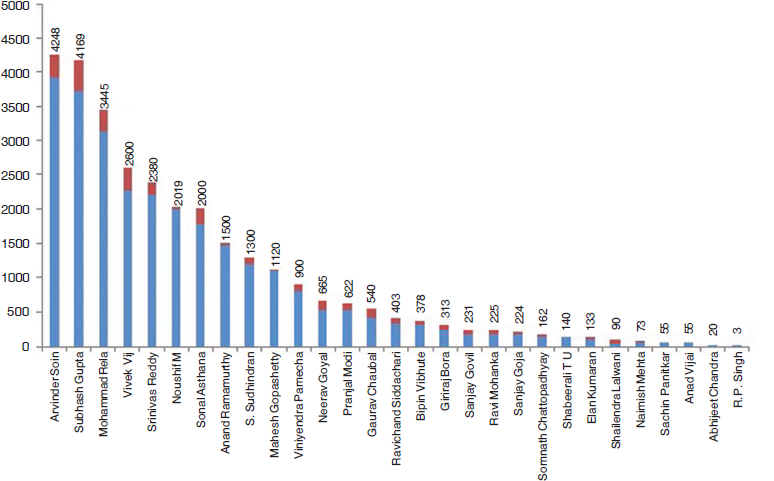
- Liver transplant surgeons and total number of procedures performed till 2022
Comparison with world data
In year 2022 India is in the third position (3920) behind the USA (9528) and China (6053) regarding the number of transplants done and is followed by Brazil (2049), Turkey (620), Italy (1479), Korea (1428), France (1297), Spain (1159) and UK (922). However, India performs the largest number of living donor liver transplants (3183) in the world followed by Turkey (1472), Korea (1086), China (754) and the USA (603). In 2009, 11% (50 of 450) transplants were from deceased donors while in 2022, 18.8% (737 of 3920) transplants were from deceased donors (Fig. 4).6
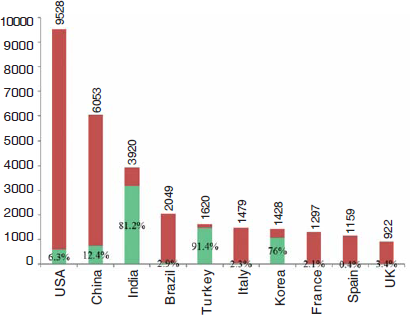
- Top 10 countries in the world in number of liver transplants performed
In many centres the overall survival in adults has been reported to be up to 95% and 1 year survival in adults has been up to 84.3% and 95% in children which matches the best world figures.8 Globally, the usual survival rates following liver transplantation are 83% to 88% after a year, 68% to 72% after 10 years, and 48% to 55% after 18 years.9 Only 2 donor deaths have been acknowledged (personal communication).
Academic output
There have been 2449 PubMed indexed publications produced from India on liver transplants. Of these there were 58 clinical trials, 595 reviews, 350 case reports, 66 editorials and the rest were original articles.
India was in the second position, after the USA, in abstract submission to the International Hepato-Pancreato-Biliary Association (IHPBA) World Congress 2024.
There are four popular medical books on Liver Transplant from India which are Textbook of liver transplantation edited by Chirag J. Desai, Techniques of liver surgery edited by Vinay Kumaran, Liver transplantation edited by A.S. Soin and S. Nundy, and Essentials of liver transplant edited by Pathik Parikh.
Private sector dominance, gender imbalance, corruption and kudos
In 2019, >95% of liver transplants were done in 175 private sector hospitals and only <5% were done in 5 hospitals in the public sector.9 There were no improvements in this ratio in 2022, with only 101 (3.3%) liver transplants performed in the public sector out of the 3069.
The reasons for the dominance of the private sector have been discussed by one of us in an editorial and briefly may be due to a lack of incentive for the amount of work the procedure involved and the difficulties of arranging simultaneous cooperation of the many departments involved in the procedure.10
There is gender discrimination in liver transplantation in India (Fig. 5) with only 22% women recipients receiving the organ from men while 68% of women donated a part of their liver to men. The mean age of the recipients was 44.2 years for men and 43.6 years for women (Fig. 5).
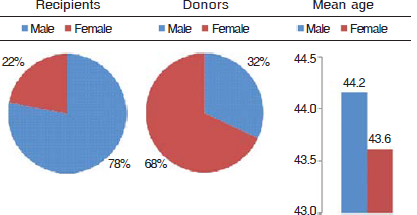
- Male Female ratio
There have been reports of kickbacks being provided to referring physicians and middlemen to send patients and false declaration of first degree relationships and emotional attachments by living donors and their agents.
Important national and International awards received by Indian Liver Transplant Surgeons are listed shown in Table II.
| National | International |
|---|---|
| Padma Shri: 1 | International Liver Transplant Society: President, Chairman, Members of Committees: 6 |
| Dr B.C. Roy Award: 2 | International grants: 12 |
| Honorary Professorship: 7 | Guinness book: 2 |
| DSc (Honoris Causa): 5 | Editorial board members: 8 |
| Medals and scholarships: 11 | Awards––BMJ and others: 12 |
| Orations: 15 |
Trainees and visitors from abroad
There were 384 foreign trainees from 52 countries (Fig. 6).
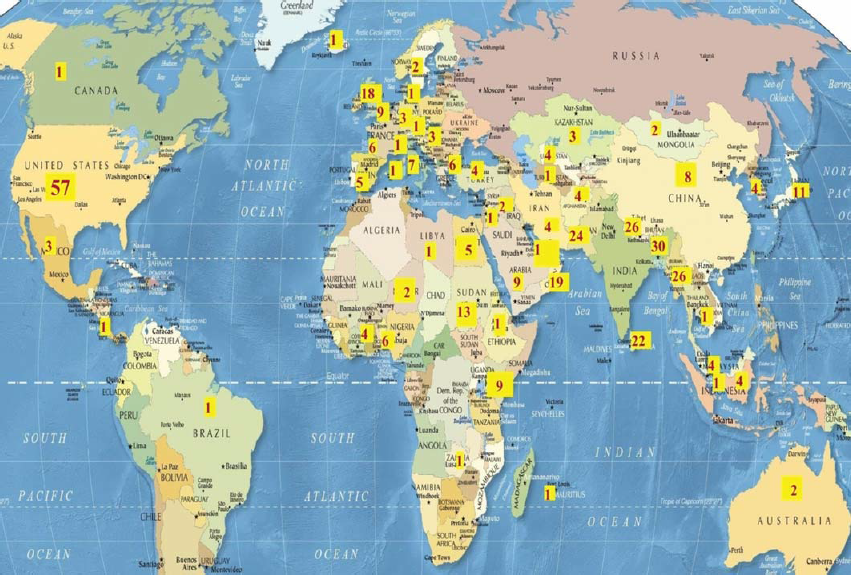
- Foreign liver transplant trainees
DISCUSSION
The much needed introduction of liver transplantation into India has faced many challenges, including the absence of legislation on brain death, countering the widespread immoral but legal kidney trade, a shortage of expertise and the high cost of the procedure. However, most of these hurdles have been systematically addressed and overcome through public awareness campaigns, legislative advancements, and collaborative efforts. 3920 procedures were performed in 2022 making India the third most prolific country in the world after the USA and China and performing the largest number of living donor procedures worldwide and attracting trainees from mainly developing and even developed countries.6 However, problems remain which include the cost of the procedure, shortage of brain dead donors, the gender imbalance, dominance of the private sector, undisclosed complications, and corruption-related practices such as kickbacks for referrals.
The cost we believe can be brought down by the increasing competition, the number of brain dead donors by public education and honouring donor families and the gender imbalance will improve with the increasing power and importance of women in our society. It will be difficult to improve the performance of the public sector unless more resources are allocated to the procedure including rewards to those involved. It will also be difficult to monitor the complication rates for this procedure as it is for other operations performed in India and so called ‘kickbacks’ for referrals often include the debatable fees paid to middlemen who facilitate the transplant journey for foreign patients.
On an encouraging note we gather that the Indian Liver Transplant Registry, developed by the Liver Transplant Society of India over the past 5 years, is collecting and reviewing the transplant data provided by all its members.11
Conclusion
Despite these challenges, liver transplantation has had a major impact on Indian healthcare, saving numerous middle-class lives and contributing to advancements in surgery, anaesthesia, hepatology, blood transfusion, and pathology. The best centres in India are now comparable to the best in the world. While the existing problems are challenging, we have hope that they will be overcome in the not too distant future.
References
- Liver transplantation: Past, present and future. Nat Rev Gastroenterol Hepatol. 2013;10:434-40.
- [CrossRef] [PubMed] [Google Scholar]
- Remembering India’s first heart transplant surgery. 2016. Livemint. Available at www.livemint.com/Science/ER42epr7fhSfpB06bpgYPI/Remembering-Indias-first-heart-transplant-surgery.html (accessed on 4 Jan 2020)
- [Google Scholar]
- Liver transplantation in the developing world. Indian J Pediatr 1999(1 Suppl):S120-S123.
- [Google Scholar]
- Directorate General of Health Services, Ministry of Health and Family Welfare, Government of India. Transplant Data 2022-Statewise. Available at https://notto.mohfw.gov.in/WriteReadData/Portal/News/815_1_2022_DATA_STATEWISE.pdf (accessed on 24 Apr 2024)
- [Google Scholar]
- Data and charts. Available at www.transplant-observatory.org/ (accessed on 24 Apr 2024)
- [Google Scholar]
- Approved Hospitals List. Available at https://notto.mohfw.gov.in/approvedhospitalslist.htm (accessed on 24 Apr 2024)
- [Google Scholar]
- Liver transplant outcomes in India. Clin Liver Dis. 2022;19:32-5.
- [CrossRef] [PubMed] [Google Scholar]
- Liver transplantation: A systematic review of long-term quality of life. Liver Int. 2014;34:1298-313.
- [CrossRef] [PubMed] [Google Scholar]
- Why are so few liver transplants done in the public sector in India and how can we improve the numbers? J Clin Exp Hepatol. 2022;12:1029-30.
- [CrossRef] [PubMed] [Google Scholar]
- Liver Transplant Society of India. Available at https://iltr.org/ (accessed on 1 Jan 2025)
- [Google Scholar]




